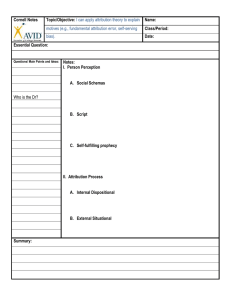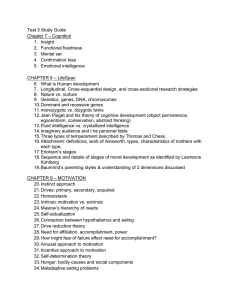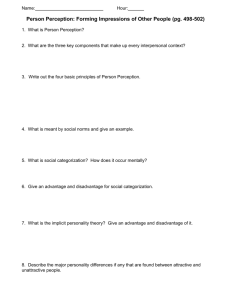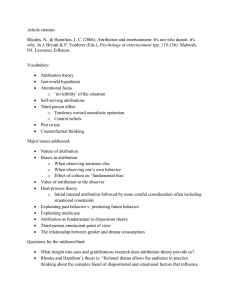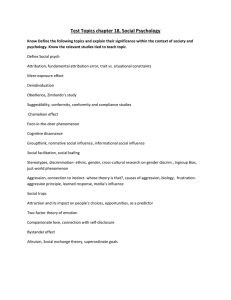Jan 28 PBB Steering Committee
advertisement
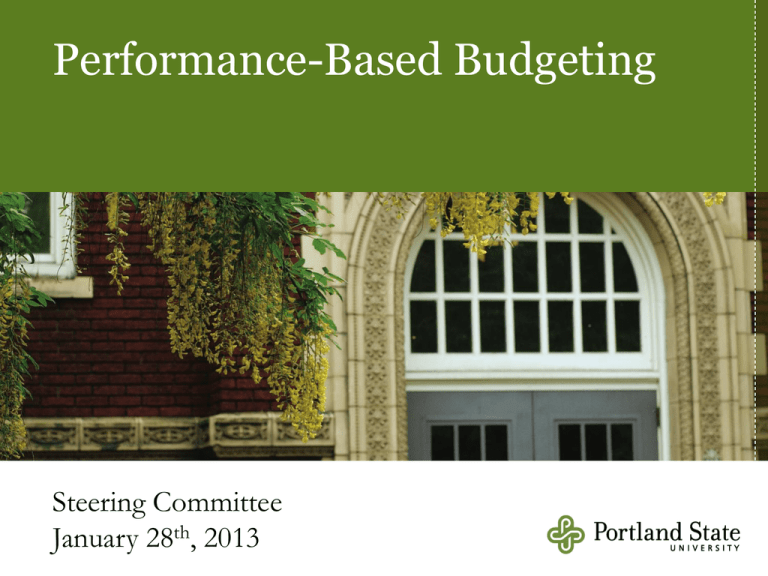
Performance-Based Budgeting Steering Committee January 28th, 2013 Agenda Introductions (Monica and Sona) Where we left off (Monica) PBB working group report -attribution tool Revenue Costs (Direct and Indirect) Next… moving from an attribution tool to PBB (Sona) Where we left off 2011-2012 Built a Revenue and Cost Attribution tool – prelude to PBB Essential for understanding our budgetary environment (long term: revenue = expenses) Attribution tool is not the budget model The attribution tool is not an SCH model. It examines the source of all revenue and attributes it accordingly . It will adjust to future changes (State Allocation based on degrees granted, credit for prior learning versus SCH) Cross subsidies are acceptable, but must be understood and have an upper limit. What is in a name A common language Attribution tool (AT) Budget Attribution Tool (BAT) Revenue and Cost Attribution Tool (RCAT) Other? Steering Committee Recommendation PBB Working Group The Attribution Tool SEE HANDOUT 1 Built using 2012-2013 budgets and current enrollment. REVENUE Tuition (Undergrad and Grad) Actual versus theoretical tuition collected, residency, differential, UNST classes, SCH redistributions, includes tuition from summer and Salem Center Remissions IDC (predicted, can be updated) Targeted revenue State Share of research funding State Share of Instruction Attribution Tool (Handout 1) EXPENDITURES Direct Expenses Summer Session and Salem Center Adjustments (1 year only) NACUBO Categories- (expenditure classification by function) Attribution Tool (Handout 1) EXPENDITURES Indirect Expenses- Steering group decisions (close calls) NACUBO Category Academic Support Institutional Support Driver X Y Cost Drivers Alternatives 2-Close Calls Institutional support and Indirect Component of O and M Research – fixed per steering committee instructions Summary of effect of different drivers Discussion of whether the group wishes to change drivers Effect of Different Drivers INSTITUTIONAL SUPPORT Cost Driver Student, Faculty & Staff Headcount Student, Faculty & Staff FTE Net Effect of Change in Driver OPERATIONS & MAINTENANCE Cost Driver Student, Faculty & Staff FTE Student, Faculty & Staff Headcount Net Effect of Change in Driver UGE CLAS SSW SBA GSE MCECS FPA CUPA $ 50,544 $ 11,124,858 $ 1,031,982 $ 3,115,147 $ 1,449,575 $ 2,645,555 $ 2,451,158 $ 2,896,750 $ 1,674,998 $ 12,529,519 $ 782,350 $ 2,339,343 $ 1,773,164 $ 1,457,363 $ 1,837,261 $ 2,371,572 $ (1,624,454) $ (1,404,661) $ 249,633 $ 775,804 $ (323,589) $ 1,188,191 $ 613,897 $ 525,178 UGE CLAS SSW SBA GSE MCECS FPA CUPA $ 1,442,630 $ 13,119,151 $ 1,126,328 $ 2,098,800 $ 1,675,063 $ 3,225,190 $ 3,304,710 $ 2,952,702 $ 310,474 $ 12,140,179 $ 1,300,308 $ 2,639,493 $ 1,449,539 $ 4,053,295 $ 3,732,563 $ 3,318,723 $ 1,132,156 $ 978,972 $ (173,980) $ (540,693) $ 225,524 $ (828,105) $ (427,853) $ (366,021) Total $ 24,765,570 $ 24,765,570 $ - Total $ 28,944,574 $ 28,944,574 $ - Moving from an Attribution Tool to a Performance Based-Budgeting Objectives Get input from the group on the AT At the end of today’s session we will have a better sense of: It’s effectiveness for budget modeling What modification are needed to the AT Questions for the Team What is in the AT that might make it an effective tool to “feed” a budget model? What is missing from the AT that prevents it from being an effective tool to “feed” a budget model? What is missing to “feed” an effective budget model that cannot be part of the AT? Work Session Every member of the Steering committee uses as many post-it notes possible to provide responses to each of the 3 questions (put your initials in the lower right corner) Stick post-its randomly on the white board with the appropriate question number Break up into assigned groups and categorize individual responses Label the categories Group Conversation Have a group conversation about the categories Do they feel right? What is missing?
